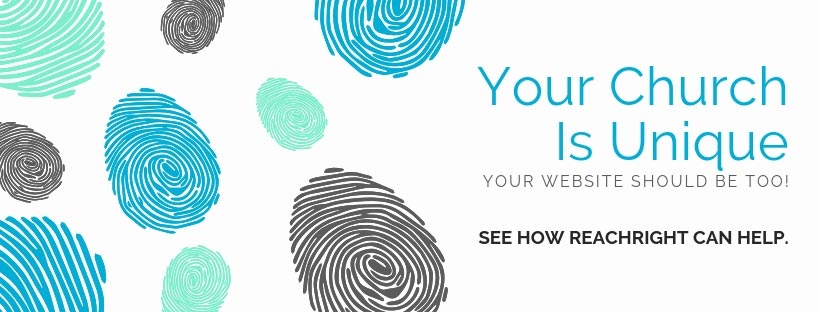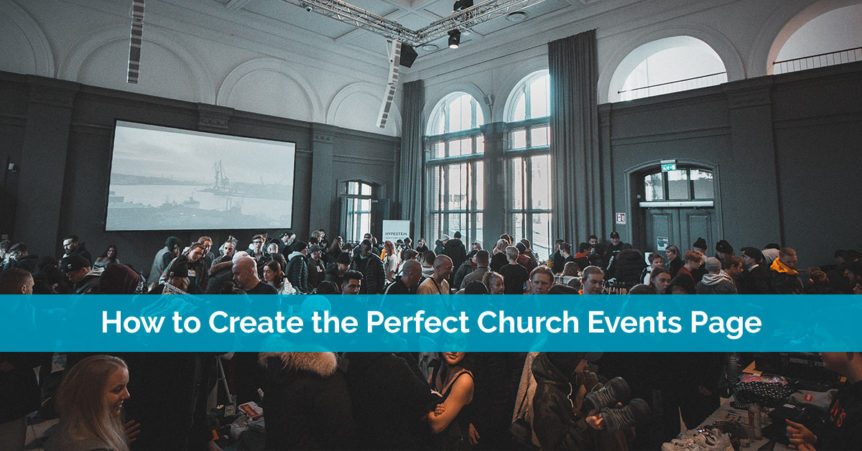Your church works hard to put on and host events, but it’s disheartening when you don’t have the crowd you’d like.
Part of the reason could be that your church’s site is missing a Church Events page.
While it may seem like something you could just list on your blog, having a dedicated events page helps draw more attention and increase event attendance.
Start With An Open Invitation
One of the best ways to start off a successful Church Events page is with an open invitation. You want to make it clear that events aren’t just for your members.
Typically, churches see the most attendance for services if it’s around a holiday or special event. While most people know they’re welcome at Christmas and Easter, they might not realize they’re just as welcome for a community picnic in the middle of June.
All you need is a few sentences as part of your header or just under it. Use a warm, friendly tone and a bold font that instantly grabs attention.
This serves as a great start to your page and encourages visitors to explore your upcoming events to see if anything appeals to them. Remember, you’re not just appealing to members, but potential new visitors and the entire community.
Use An Actual Event Image In The Header
While you should be using real images and not just stock photos on your main church website pages, you should definitely use an actual event image in your Church Events page header.

It can be a photo from any past event or an image of people putting the event together. The idea is to show just how enjoyable your church events actually are.
Combining an image from an event with smiling, laughing and highly engaged members creates the perfect welcome when paired with the open invitation.
List The Most Current Event First
Naturally, the next section should be for the events themselves. However, you should start this section by listing your next upcoming event in a larger font to draw attention.
Since this one is coming up faster, you want potential visitors to see it first and discover an opportunity to visit your church before they decide to try a different church.
Often times, new members aren’t just visitors who walk in during a random Sunday. They’re people who decided to attend an event, loved the atmosphere and started attending services too. An event is a low-pressure way to try out a new church.
So, make sure your church site visitors aren’t missing out the next chance to try out your church and meet your members and staff.
An alternative approach is to have featured events at the top. Typically, you’ll have the closest event first and then several other featured events. For the additional features, the dates don’t have to be close or even in order.
Offer A Calendar Format
One of the most popular ways to list events is via a calendar format. Did you know calendars even have the power to change how you accomplish things? Seeing something listed on a calendar versus a list encourages you to take action by providing a concrete deadline.
The same psychology works well with your Church Events page. Make your page feel more like a calendar. Just like a regular calendar, important dates stand out, which in your case, will be your events.
Provide A Filter And/Or Search Option
Churches with only a few events listed at any given time don’t really need to have a filter or search option. After all, all your events are probably easy to see without even scrolling.
If you have numerous events, your Church Events page must have a filter and/or search option. For instance, if someone is just interested in seeing upcoming group meetings, they don’t want to have to scroll through music guests and vice versa.
When your page has too many events, it can seem overwhelming. Instead of just scrolling, people get bored and move one.
Ideally, your search and filter options should be just above your calendar or list of dates. You can have both a calendar and list if you need to in order to appeal to all visitors.
Go Beyond Just The Name And Date
Now for the most important part – describing your events. There are two easy approaches to show the details.

First, if you have a standard calendar format, make each event a link. When a visitor clicks it, they’re either treated to a pop-up or a new page.
The second option is to have each event in a list format expand to show the details. This works well for churches with a limited number of events. Some
Some of the details you should list include:
- Start and end time
- Location (if it’s at your church, state which room)
- Purpose of the event
- Any restrictions, such as no food or drink
- Special considerations, such as warning about seizures during a light show
- Link to more details about performers, if applicable
- Cost, if any (list Free specifically if it’s free)
The more details you provide, the more likely people are to attend. Even if you’re announcing events during services, providing more details on your website helps to answer questions your members might have. Plus, your events page gives your members something to share with others.
List Contact Details
You’re always going to have visitors who have questions about your events. For instance, if you list a price per ticket, someone might want to know if it’s the same price for small kids.
You could let all those event-related questions get mixed in with all the contact form questions/comments for your entire website, or list a contact for people to reach out to if they have questions.
All you have to do is add a name and an email address or phone number. If you want to get fancy, you could add a small form that pops up when the visitor clicks a link that says “Have Questions?”. The form is then sent to whoever is in charge of coordinating the event.
Encourage Online Ticket Buying
Of course, this one won’t apply if you don’t have any church events that require a ticket. However, if you’re doing a fundraiser or you have to pay to have a special musician or speaker come in, you’ll want to sell tickets.
Yes, you could sell them directly at your church and require anyone who wants advance tickets to stop by. That’s not all that convenient, though.
For popular events, site visitors might want to buy a ticket early, but can’t stop by your church due to conflicting schedules or an illness like the flu.
Make it easy for people to get tickets to the church events they want to attend most. Offering an online ticketing option makes it easier for staff and volunteers. Plus, you and your attendees enjoy benefits, such as:
- Faster entry at events
- Have a better idea of attendance prior to the event
- Use ticket sale money to start planning another event to keep people coming back
- Sell more tickets overall
- Improve event marketing (a great experience leads to word of mouth recommendations)
- Save both time and money
Always remember to use a secure web portal for accepting payments to keep your visitors safe.
Ask For RSVPs
For free events or for those who may not feel comfortable buying tickets online, ask for RSVPs. While this is more to help your church, it’s an easy way to increase engagement on your site. Plus, when someone RSVPs, they may be more likely to share the news with friends and family.

For your church, you’re able to get a clearer idea of how many people may attend. While an RSVP isn’t a 100% guarantee, it increases the odds. For any events involving food, RSVPs are incredibly helpful in helping you prepare.
Add a section in the event description so visitors can easily RSVP. Visitors can add their name/email address so you can send them a reminder the day before the event.
Another option is to connect your Church Events page with your church’s Facebook events. Any site visitors with a Facebook account can then RSVP via Facebook.
Provide Event Sharing Features
You already know that social media is a valuable marketing tool for your church. That’s why, if you want more attendees at your church events, you should make easy for your site’s visitors to share events to their favorite social media platforms.
Personal recommendations and customer reviews are the two most important elements when it comes to building trust. By encouraging sharing, visitors and members are sharing their personal recommendation to attend a specific event. If it’s an event you’ve held before, ask any members who enjoyed the previous event to also share why they like it along with sharing the event details.
Since 88% of people trust reviews as much as recommendations, it’s a win-win for your church. As a side note, monitor how effective this strategy is for increasing visits to your Church Events page.
Add Images From Past Events
For any events you’ve held before, make them seem even more appealing by adding an actual image from the event. A great way to do this is by using the image as the background for the event name, date and time. You can do this in all types of calendar formats and list formats.
If you don’t want to add an image for every event, only add an image for your featured event(s). This helps those events stand out from the rest.
Another option is to add a few images to individual pages if you’re linking the event to a web page dedicated to that particular event.
Include A Newsletter Signup
Your Church Events page is the perfect place to ask visitors to sign up for your church’s newsletter. Use a call-to-action to the right or the bottom of your event page.

While you should test the effectiveness of the placement of the CTA for your church, these are usually the two best areas. If you have a longer page, it’s beneficial to place your CTA to the right so visitors who may not scroll to the bottom will still see it.
If you don’t have a newsletter, it’s a good idea to start one. You don’t have to go overboard. Instead, just offer notes about upcoming events, links to your latest blog posts and a daily or weekly devotional.
Offer A Reminder Option
No matter what else is on your Church Events page, make sure it includes two things – the event details and a reminder option.
Even though you have the event clearly listed, this doesn’t mean visitors will remember the date. Plus, it’s all too easy to get distracted online and forget to add the date to a phone, planner or even just a sticky note.
Ask visitors to sign up for reminders about the upcoming event. This is especially important with any events scheduled far in advance. All you need is an email address or mobile number to send a quick reminder.
The last thing you want is to find out your church is only half full because people forgot the date.
To encourage more people to sign up, ensure them the data they provide will only be used for that purpose. You can remove reminder emails/numbers from your databases to ensure better privacy – something most everyone appreciates.
Popular Layout Options
Of course, a visual always help you get a better idea of how to create the perfect Church Events page.
While there isn’t just one right way to do it, you can get inspiration on what your audience might like best by checking out these different events pages from other churches:
- Lakewood Church – A nice list/calendar-style mix
- Saddleback Church – Good way to handle numerous events in a familiar planner style
- Rock Church – Perfect example of featured events and using visuals
- The United Methodist Church – Great example of using filters and search features
- Cedar Park Church – Lists events with visuals and details along with providing a separate traditional calendar option
Most importantly, never just copy, just get inspired. Ask for feedback from your members to ensure your Church Events page is easy to use.
Need help creating the perfect Church Events page? Learn how our web design services can help ensure more people see your upcoming events.




